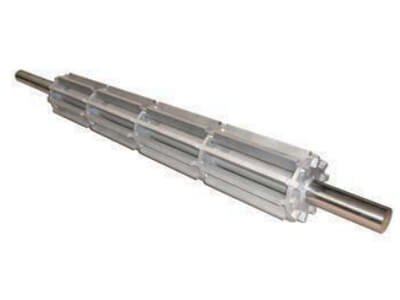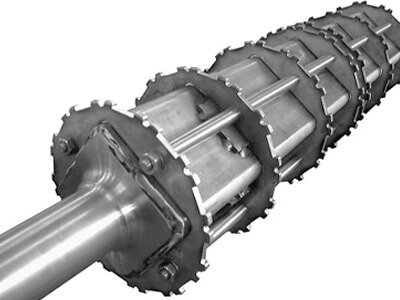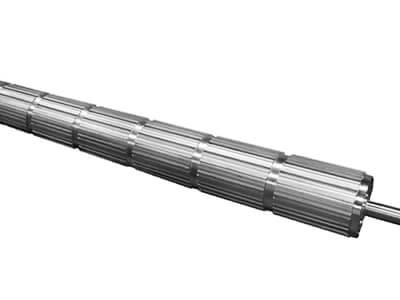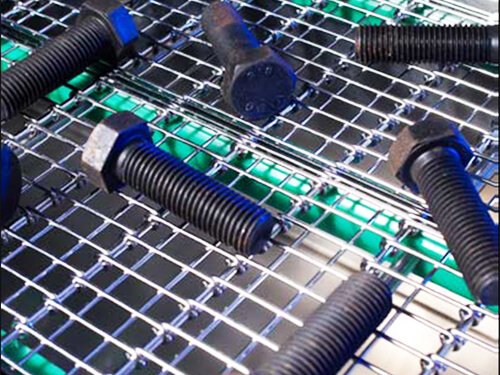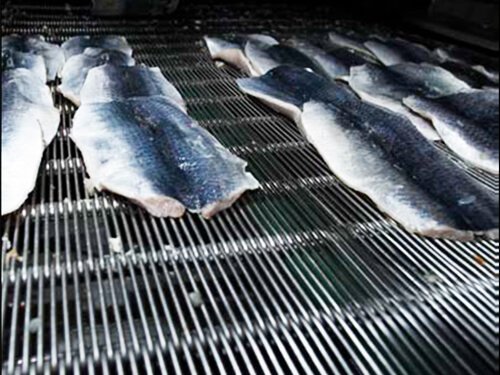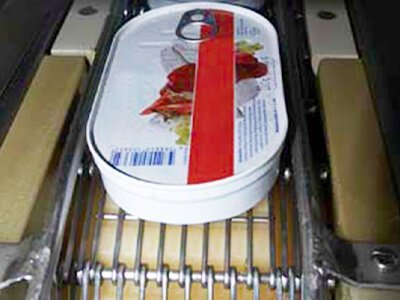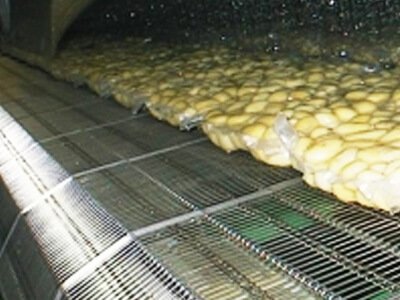Eye Link Conveyor Belts
HOME / PRODUCTS / Metal Conveyor Belts / Eye Link Conveyor Belts
Flat Surface Heavy-Duty Modular Eye Link Conveyor Belts For Either Industrial Or Food Processing Applications
Eye link conveyor belts as known as Eye-Flex conveyor belts. The design of eye link conveyor belts typically involves a series of interconnected eye links or eye link modules. When these modules are joined with cross rods, they create a flat and robust surface. These belts are commonly made of stainless steel or other alloys.
Eye Link Conveyor Belts are utilized in various industries, including industrial and food processing applications, owing to their stability, durability, high strength, and versatility.
The customization options and adaptability of Eye Link Conveyor Belts make them well-suited for harsh applications that demand an extremely heavy-duty belt.
Specification
| Available Material | Carbon Steel, SS 304, SS 316, other materials available upon request |
| Chain pitch | 25.4 mm, 31.75 mm, 38.1 mm, 50.8 mm, 63.5 mm, 76.2 mm |
| Cross Rod diameter | 5 mm, 6 mm, 7 mm, 8 mm, 10 mm, 12 mm |
| Eye Link Wire diameter | 1.5 mm, 1.6 mm, 1.8 mm, 2 mm, 2.5 mm, 3 mm, 3.5 mm |
| Spiral pitch | 2.4 mm to 100 mm |
| Cross Rod pitch | 25.4 mm, 31.75 mm, 38.1 mm, 50.8 mm, 63.5 mm, 76.2 mm |
| Belt width | 100 mm to 6,000 mm |
| Maximum Temperature | Up to 400 °C |
Belt Types
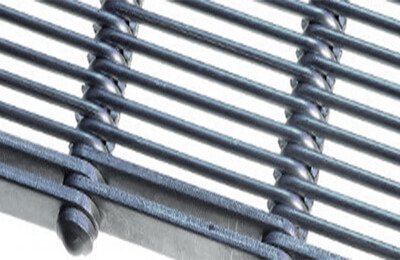

Full Eye Link Belts
The fundamental concept of all full eye link belt versions involves the eyelinks lying against each other, with the opening being equal to the wire diameter. This configuration is particularly well-suited for applications where products are prone to falling or when small openings are essential.
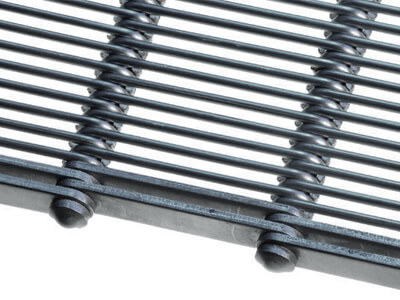

Pressed Eye Link Belts
In certain applications demanding minimal openings, the pressed eye link belt is employed. This design achieves the smallest opening possible by flattening the eyes of the eyelinks, making it highly suitable for conveying small and finely-structured products.
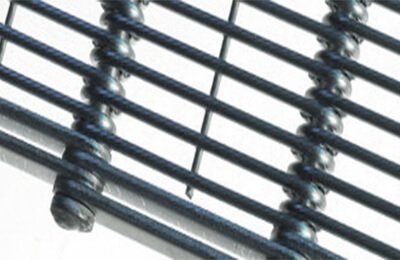

Welded Eye Link Belts
The welded eye link belt involves welding the eyelinks onto a location wire, forming a module. This allows for the creation of openings that can be either very narrow or very wide, depending on the characteristics of the processed products. The assembly of eyelinks can be adjusted according to either European or American standards, based on hygiene requirements and specific application needs.
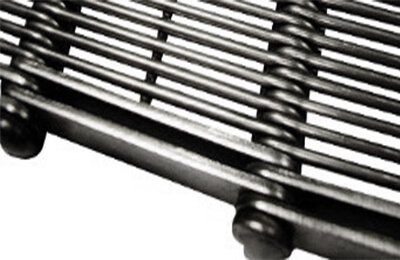

Pressed and Welded Eye Link Belts
For applications necessitating both a stable belt and a small opening or drainage capability, the pressed and welded eye link belt is employed. The precision of our welding process enables the creation of modules with minimal intervals between the eyelinks. This modular structure facilitates the assembly of belts with broad configurations, catering to diverse industrial needs.
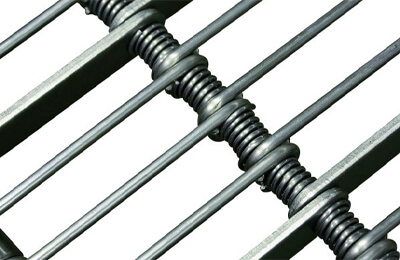

Eye Link Belts with Springs
The eye link belt with springs incorporates springs positioned between the eyelinks, maintaining regular intervals. This design yields a relatively lightweight belt with distinct attributes, including excellent shock resistance and resistance to lateral forces. These qualities are particularly crucial in scenarios where the conveyor belt undergoes manual loading and/or lateral stresses.
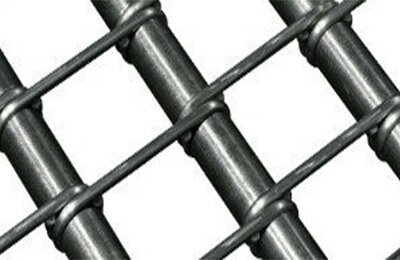

Eye Link Belts with Bushings or Washers
The eye link belt with bushings or washers involves the use of these components to generate openings between the eyelinks. The inclusion of bushings or washers results in increased weight and rigidity of the belts.
Edge Availability
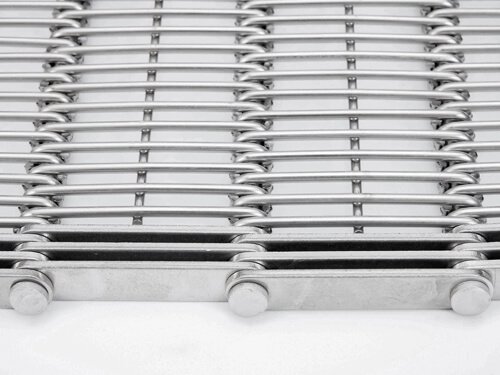

Reinforcing Plates Eye Link Belts
Eye Link Conveyor Belts with reinforcing plates incorporate additional reinforcing plates to enhance the strength and durability of the conveyor belt. These reinforcing plates provide additional support and structural integrity, making the belts well-suited for heavy-duty applications or situations where extra strength is required to handle challenging materials or conditions. The incorporation of reinforcing plates can contribute to the overall robustness and longevity of the conveyor belt in various industrial settings.
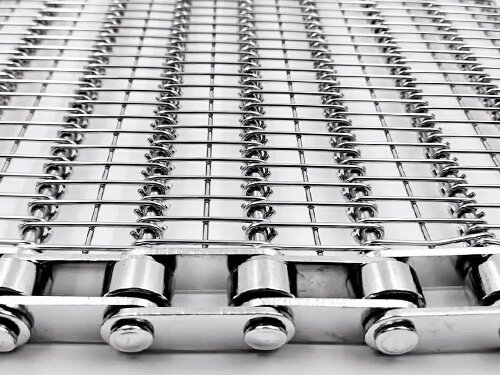

Chain Edge Eye Link Belts
Eye Link Conveyor Belts with Chain Edge incorporate a chain edge mechanism for enhanced tracking, stability, and reliability during the conveying process. The chain edge provides additional support and control, helping to ensure that the belt stays aligned and on its intended path. This feature is particularly useful in applications where precise movement and positioning of the conveyed items are critical. The combination of eye link design and a chain edge mechanism makes these conveyor belts suitable for demanding industrial environments, providing a robust solution for material handling.
Other Options
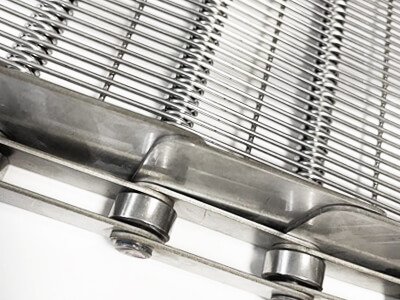

Eye Link Belts with Guard Edge
Eye Link Conveyor Belts with Guard Edge feature a guard edge mechanism to enhance product containment and prevent items from falling off the sides of the conveyor. The guard edge serves as a protective barrier, ensuring that products remain within the confines of the conveyor belt throughout the conveying process. This design is particularly beneficial in applications where product spillage or loss is a concern, such as in industries with stringent hygiene or safety requirements. The incorporation of a guard edge adds an extra layer of security and containment to the conveyor system.
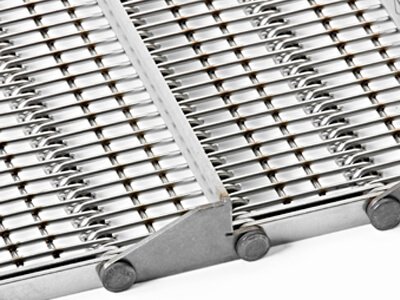

Eye Link Belts with Flights
Eye Link Belts with flights are designed with raised elements, known as flights or cleats, attached to the belt at intervals. These flights serve various purposes in the material handling process. Eye Link Belts with flights are often used in applications where incline or decline conveying is required. The flights provide additional grip and prevent products from slipping on inclined or declined surfaces.
Methods of Drive
Eye Link Conveyor Belts can be driven through various mechanisms, each tailored to specific applications:
1. Sprockets Drive:
– Generally, Eye Link conveyor belts are driven directly on the eyelinks using specially developed drive sprockets.
– Sprockets are typically placed at both sides and under each row of plate links.
– The width, number of teeth, and material of the sprockets are determined based on usage conditions.
– Sprockets are available in materials such as steel, stainless steel 304 and 316, PA6, and POM, with customization options.
2. Cage Rollers Drive:
– Broad and heavily loaded eyelink conveyor belts are preferably driven by cage rollers across the width of the belt.
– Cage rollers drive the eyelinks regularly, promoting a longer belt lifespan and even wear.
3. Disc Rollers Drive:
– Preferred in situations where there is a risk of filth or ice accumulation.
– Disc rollers with discs, arranged in multiples of the cross pitch, offer different driving functions:
* Drive on the cross rod
* Drive on the cross rod with a ‘lifting function,’ lifting products for discharge.
4. Tube Rollers Drive:
– With replaceable strips, plastic, or soft-metal strips in the grooves limit deflection and allow for replaceable drive components.
– With replaceable teeth are advantageous for long, broad, and heavily loaded belts, offering a reversible roller for extended strip and teeth life cycles.
5. Chain Sprockets Drive:
– Eyelink belts can incorporate chains, especially in applications with negative bends, such as freezing or blanching.
– Chain sprockets replace side-sprockets in these applications.
– Saryee belting recommends sprockets with at least 12 teeth to minimize the polygon effect on belt run.
– The necessary number of teeth depends on factors like belt width, length, load, and running speed.
Common Specifications of Eye Link Conveyor Belts
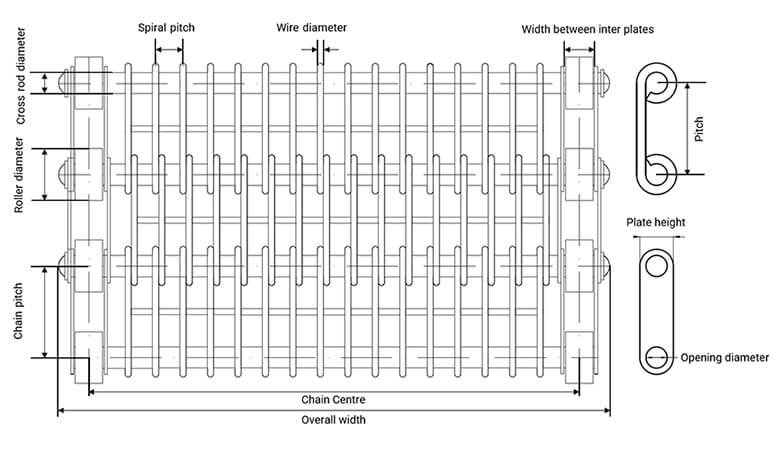

| Specification for Full Eye Link Belts | |||
| Item | Belt Pitch | Wire Dia. | Cross Rod Dia. |
| mm | mm | mm | |
| SYELCB01 | 15.875 | 1.8 | 3.2 |
| SYELCB02 | 25 | 2 | 5 |
| SYELCB03 | 25.4 | 2 | 5 |
| SYELCB04 | 30 | 1.6 | 4 |
| SYELCB05 | 30 | 2 | 4 |
| SYELCB06 | 30 | 2 | 5 |
| SYELCB07 | 30 | 2 | 7 |
| SYELCB08 | 30 | 2 | 8 |
| SYELCB09 | 31.75 | 2 | 5 |
| SYELCB010 | 50 | 1.4 | 5 |
| SYELCB011 | 50 | 1.6 | 5 |
| SYELCB012 | 50 | 2 | 5 |
| SYELCB013 | 50 | 2.5 | 6 |
| SYELCB014 | 50 | 2.5 | 8 |
| SYELCB015 | 50 | 3 | 5 |
| SYELCB016 | 50.8 | 1.6 | 8 |
| SYELCB017 | 50.8 | 1.6 | 6 |
| SYELCB018 | 50.8 | 2 | 8 |
| SYELCB019 | 50.8 | 2.5 | 8 |
| SYELCB020 | 50.8 | 2.5 | 5 |
| SYELCB021 | 50.8 | 3 | 5 |
| SYELCB022 | 50.8 | 4 | 7 |
| SYELCB023 | 60 | 2 | 5 |
| SYELCB024 | 60 | 2.5 | 5 |
| SYELCB025 | 70 | 4 | 7 |
| SYELCB026 | 75 | 2.5 | 5 |
| SYELCB027 | 75 | 2.5 | 8 |
| SYELCB028 | 100 | 3 | 8 |
| NOTE: Custom specification is available if you can’t find the suitable size. | |||
| Specification for Welded Eye Link Belts | ||||||
| Item | Belt Pitch | Wire Diameter | Cross Rod Diameter | Minimum gap spacing | Gap in steps of | Maximum No. of welded wires |
| mm | mm | mm | mm | mm | mm | |
| SYELWB01 | 15.88 | 1.8 | 3.2 | 2 | 0.1 | 1 |
| SYELWB02 | 25 | 2 | 5 | 2.3 | 0.1 | 2 |
| SYELWB03 | 25.4 | 2 | 5 | 2.3 | 0.1 | 2 |
| SYELWB04 | 30 | 2 | 4 | 2.3 | 0.1 | 2 |
| SYELWB05 | 30 | 2 | 5 | 2.3 | 0.1 | 2 |
| SYELWB06 | 50 | 2 | 5 | 2.3 | 0.1 | 3 |
| SYELWB07 | 50 | 2.5 | 5 | 2.8 | 0.1 | 3 |
| SYELWB08 | 50 | 2.5 | 6 | 2.8 | 0.1 | 3 |
| SYELWB09 | 50.8 | 2.5 | 8 | 2.8 | 0.1 | 3 |
| SYELWB010 | 50.8 | 3 | 8 | 3.3 | 0.1 | 3 |
| SYELWB011 | 75 | 2.5 | 5 | 2.8 | 0.1 | 3 |
| SYELWB012 | 75 | 2.5 | 8 | 2.8 | 0.1 | 3 |
| NOTE: Custom specification is available if you can’t find the suitable size. | ||||||
| Specifications for Eye Link Belts with Rings as Spacers | |||||
| Item | Belt Pitch | Wire Diameter | Cross rod Diameter | Minimum Gap Spacing | Increased by |
| mm | mm | mm | mm | mm | |
| SYELRB01 | 25 | 2 | 5 | 4 | 2 |
| SYELRB02 | 25.4 | 2 | 5 | 4 | 2 |
| SYELRB03 | 30 | 2 | 4 | 4 | 2 |
| SYELRB04 | 30 | 2 | 5 | 4 | 2 |
| SYELRB05 | 31.75 | 2 | 5 | 4 | 2 |
| SYELRB06 | 50 | 2 | 5 | 4 | 2 |
| SYELRB07 | 50 | 2.5 | 5 | 5 | 2.5 |
| SYELRB08 | 50 | 2.5 | 6 | 5 | 2.5 |
| SYELRB09 | 50.8 | 2.5 | 6 | 5 | 2.5 |
| SYELRB010 | 50.8 | 2.5 | 8 | 5 | 2.5 |
| SYELRB011 | 50.8 | 4 | 8 | 8 | 4 |
| SYELRB012 | 60 | 2 | 5 | 4 | 2 |
| SYELRB013 | 60 | 2.5 | 5 | 5 | 2.5 |
| SYELRB014 | 75 | 2.5 | 5 | 5 | 2.5 |
| SYELRB015 | 75 | 2.5 | 8 | 5 | 2.5 |
| NOTE: Custom specification is available if you can’t find the suitable size. | |||||
| Specification for Eye Link Belts with Springs | ||||||||||
| Item | Belt Pitch | Wire Diameter | Cross Rod Diameter | Min. gap spacing | Gap spacing also available in these widths | |||||
| mm | mm | mm | mm | mm | ||||||
| SYELSB01 | 25 | 2 | 5 | 7 | 8 | 10 | 12 | 15 | 17.5 | 20 |
| SYELSB02 | 25.4 | 2 | 5 | 7 | 8 | 10 | 12 | 15 | 17.5 | 20 |
| SYELSB03 | 30 | 2 | 4 | 7 | 8 | 10 | 12 | – | – | 20 |
| SYELSB04 | 30 | 2 | 5 | 7 | 8 | 10 | 12 | 15 | 17.5 | 20 |
| SYELSB05 | 31.75 | 2 | 5 | 7 | 8 | 10 | 12 | 15 | 17.5 | 20 |
| SYELSB06 | 50 | 2 | 5 | 7 | 8 | 10 | 12 | 15 | 17.5 | 20 |
| SYELSB07 | 50 | 2.5 | 5 | 7.5 | 8 | 10 | 12 | 15 | 17.5 | 20 |
| SYELSB08 | 50 | 2.5 | 6 | 7.5 | – | – | – | – | – | 20 |
| SYELSB09 | 50 | 3 | 8 | 10.5 | – | – | – | 15.5 | – | 20 |
| SYELSB010 | 50.8 | 2 | 6 | 7 | – | – | – | – | – | – |
| SYELSB011 | 50.8 | 2 | 8 | 8 | – | – | – | – | – | – |
| SYELSB012 | 50.8 | 2.5 | 6 | 7.5 | – | – | – | – | – | 20 |
| SYELSB013 | 50.8 | 2.5 | 8 | 10 | – | – | – | 15 | – | 20 |
| SYELSB014 | 50.8 | 3 | 8 | 10.5 | – | – | – | 15.5 | – | 20 |
| SYELSB015 | 50.8 | 4 | 8 | 12 | – | – | – | – | – | – |
| SYELSB016 | 60 | 2.5 | 5 | 7 | 8 | 10 | 12 | 15 | 17.5 | 20 |
| SYELSB017 | 60 | 2.5 | 5 | 7.5 | 8.5 | 10 | 12 | 15 | 17.5 | 20 |
| SYELSB018 | 70 | 4 | 7 | 12 | – | – | – | – | – | – |
| SYELSB019 | 75 | 2.5 | 5 | 7.5 | 8.5 | 10 | 12 | 15 | 17.5 | 20 |
| SYELSB020 | 75 | 2.5 | 8 | 10 | – | 10 | – | 15 | – | 20 |
| SYELSB021 | 100 | 3 | 8 | 10.5 | – | 10.5 | – | 15.5 | – | 20 |
| NOTE: Custom specification is available if you can’t find the suitable size. | ||||||||||
Eye Link Conveyor Belts offer several advantages that make them a preferred choice in various industries for material handling and conveying applications. Here are some key advantages of eyelink conveyor belts:
- Modularity
Eye Link Conveyor Belts are constructed in a modular fashion with interlocking metal links or modules. This modular design allows for easy customization, repair, and replacement of individual components, making them versatile and adaptable to different conveyor configurations. - Stability and Durability
The design of eye links and the use of materials like stainless steel contribute to the stability and durability of these conveyor belts. They can withstand heavy loads, resist wear and tear, and operate reliably in demanding industrial environments. - Versatility
Eyelink conveyor belts are versatile and suitable for a wide range of applications in industries such as food processing, pharmaceuticals, chemicals, and packaging. Their adaptability makes them valuable for conveying different types of products. - Ease of Cleaning
The open mesh configuration of eye link belts facilitates easy cleaning, making them suitable for industries with strict hygiene standards. This feature is crucial in applications where cleanliness is essential, such as in food processing. - Customization
Eye Link Conveyor Belts can be customized based on specific application requirements, including belt width, length, pitch, and the type of eyelinks used. This customization ensures that the belts can meet the unique needs of different material handling processes. - Various Drive Mechanisms
Eye Link Conveyor Belts can be driven using different mechanisms, including sprockets, cage rollers, disc rollers, tube rollers, or chain sprockets. The flexibility in drive options allows for the selection of the most suitable mechanism for specific applications. - Temperature Resistance
Some variations of Eye Link Conveyor Belts are designed to withstand high temperatures, making them suitable for applications involving heat-treating processes or baking. - Specialized Variations
Eye Link Conveyor Belts come in specialized variations, such as those with flights, reinforcing plates, or guard edges, to address specific needs in different industries. - Excellent Air and Fluid Drainage
The open mesh configuration of eye link belts allows for excellent air and fluid drainage, which can be advantageous in applications where drainage is critical. - High Strength and Carrying Capacity
Eye Link Conveyor Belts are known for their high strength and excellent carrying capacity, making them suitable for conveying heavy loads and bulk materials.
Eye Link Conveyor Belts find applications across various industries due to their versatility, stability, and durability. Here are common applications of Eye Link Conveyor Belts:
Food Processing Industry:
Conveying Food Products: Eye Link Conveyor Belts are widely used for transporting food products, such as baked goods, snacks, fruits, and vegetables, in food processing facilities.
Pharmaceutical Industry
Drug Manufacturing: In pharmaceutical manufacturing, these belts are used for the transportation of pharmaceutical products during different stages of production.
Packaging Industry
Packaging Lines: Eye Link Conveyor Belts are employed in packaging lines for the smooth and efficient movement of packaged goods, cartons, and boxes.
Chemical Industry
Chemical Manufacturing: These conveyor belts are used in the chemical industry for conveying various chemicals, raw materials, and finished products.
Automotive Industry
Assembly Lines: Eye Link Conveyor Belts are utilized in automotive assembly lines for the movement of parts and components during the manufacturing process.
Metalworking Industry
Metal Fabrication: In metalworking, these belts are employed for conveying metal parts and products during cutting, shaping, and finishing processes.
Electronics Industry
Electronic Component Manufacturing: Eye Link Conveyor Belts are used in the electronics industry for the transportation of electronic components and devices.
Bakery Industry
Baking Lines: These belts are ideal for conveying dough, baked goods, and other bakery products in baking and pastry production lines.
Heat-Treating Processes
High-Temperature Applications: Some variations of Eye Link Conveyor Belts are designed to withstand high temperatures, making them suitable for heat-treating processes in industries like metalworking.
Freezing and Blanching Applications
Food Freezing: In the food industry, Eye Link Conveyor Belts with specialized features, such as ice-crusher sprockets, are used for freezing or blanching applications.
Hygienic Environments
Cleanroom Applications: The open mesh configuration and ease of cleaning make these belts suitable for cleanroom environments, such as in the production of sensitive electronic components or pharmaceuticals.
General Material Handling
Bulk Material Transport: Eye Link Conveyor Belts are employed in general material handling applications for the transportation of bulk materials, goods, and products.


